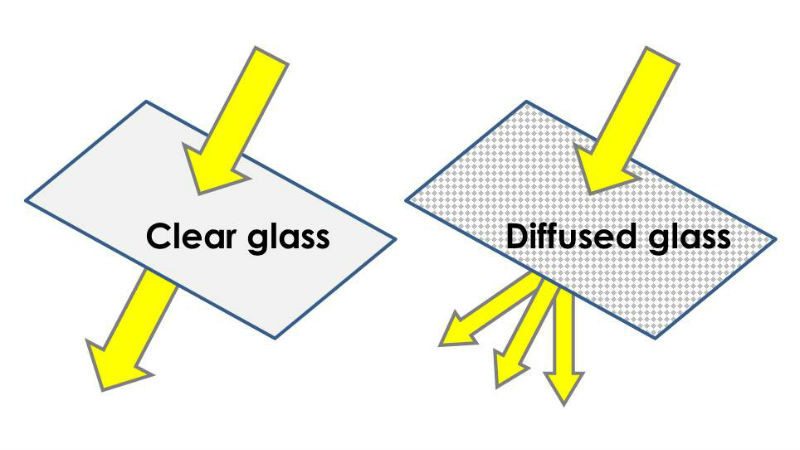
Diffused Glass
Glass has been used as a greenhouse glazing material for many decades primarily because of its high transmission of light and longevity. However, compared with other glazing options, glass is expensive and has poor insulation properties. Although glass transmits a high percentage of sunlight, most of that light penetrates through the glazing in a directional manner; very little is diffused. Therefore, although more light enters a glass-glazed greenhouse than most other glazing options, on sunny days the
uniformity of that light is poor since the structure and overhead obstructions (heat pipes, hanging baskets, etc.) cast distinct shadows on crops below.
In addition to being relatively inexpensive, two layers of inflated polyethylene have a high insulation value and most materials transmit light in a fairly scattered manner. The result is a more uniform light environment for crops inside. However, double poly transmits less sunlight than glass and it needs to be replaced periodically.
Diffused glass is usually created by treating the surface of low-iron glass to create patterns that scatter the light. A challenge is to “scratch” the glass without creating a surface that allows dust to accumulate. Several companies have been working on this technology with apparently good outcomes.
Until recently, the diffusion process reduced the transmission of photosynthetic light, but today reported transmissions are essentially as good as non-treated, clear glass. Anti-reflection coatings to one or both sides of the diffused glass can further increase light transmission to crops below.
Researchers at Wageningen University in the Netherlands have performed several projects with diffused glass including improvements to the environment and growth of greenhouse crops. Compared with clear glass, diffused glass can:
- Increase the uniformity of the greenhouse climate, especially temperature and light conditions
- Increase fruit production (by 5 to 10 percent) of high-wire tomato and cucumber crops
- Increase flowering and reduce production time of potted crops such as chrysanthemum and anthurium
Diffused glass is more expensive than regular glass, but in some situations the benefits are apparently worth the cost;
a Dutch academic recently estimated that 90 percent of new greenhouses being built in the Netherlands (many of which are used to grow vegetable crops) have diffused glass.
Glass is a much more common glazing material in the Netherlands for several reasons, including their more northern latitude (Amsterdam is 52°N latitude; for comparison, Calgary in Canada is 51°N latitude), the abundant production of high-light requiring crops such as tomato and rose, their comparatively mild winters, and typical year-round production.
The benefits of diffused glass could be more pronounced in regions with abundant sunny weather because clouds already scatter sunlight. Benefits could also be more pronounced for tall-growing crops or those with a dense canopy. High-wire crops such as tomato and pepper would especially benefit, since more light would reach leaves deeper into the tall canopies. In the United States, growers need to weigh the advantages of diffused glass with its cost considering their location, production periods, and types of crops grown.
Erik Runkle is professor and floriculture extension specialist in the department of horticulture at Michigan State University. He can be reached at runkleer@msu.edu.


 Video Library
Video Library 




















